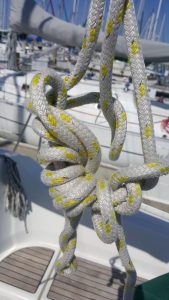Have you ever felt that way? So have I. Sadly, you and I are probably the reason the line is all twisted up. Most of us are guilty, especially while we are learning, of doing one or both of the following “bad things”.
Coiling the line wrong!
There is a lot of disagreement regarding the proper way to coil a line. The reason? There are two different types of line, layed and braided. Each needs to be coiled differently. If you learned to coil layed line, you are probably going to coil braided line incorrectly, and visa versa if you learned on braided line. How do you stop the kinks?
When coiling a layed line, the line will naturally fall in nice clean coils … in other words … no figure 8’s. When coiling a braided line, it will naturally fall into a figure 8 pattern. If you remove the figure 8 pattern, every loop introduces a twist. Over time, coiling over and over will make a nasty mess. Let the line fall naturally while coiling. The line will naturally do what is needed to not twist. The benefit is a line which runs free without getting kinked. Also, never coil line from the bitter end.
Putting a line on a winch.
Yeah, I know, that’s what a winch is for. Just remember. Every wrap on a winch introduces twist. If you don’t remove the twists regularly, problems develop.
While we are on the topic of line and winches. For safety, there are two lines that should never go on a winch. Furling lines and reef lines. These lines are not strong enough to withstand the pressures generated by a winch. Neither is the forestay when furling a jib. Truth is, if you need a winch, you are doing something wrong. Jibs should be furled (and reefed) on a broad reach to run while the jib is blanketed by the main. No wind, no load, no problem. Mainsail reefs should be put in while close hauled, with the main luffing. Again, no load, no problem.
Once twists are introduced, the only way to get rid of them is to start at the end (NOT the bitter end) and untwist the line. You may need to do it a few times to get rid of all the twists, however, it’s well worth it. Twists make lines work poorly, and cause damage when cuckolded (that ever-hated kink or a..hole we all dread.)



Nice article Don!
Great article! Re furling lines on winches, we furl/unfurl everything by hand on our 45′ cutter. You get instant feedback if there’s something jammed in the furling system — something you’d likely miss if you used a winch. I know the internet has lots of opinions on what the best practice is, and I’m sure there are exceptions, but I think you’re absolutely right Don.